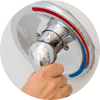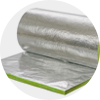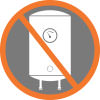In one day alone, the average household uses 64 gallons of water, equivalent to 23,360 gallons of water per year. It’s no wonder your water heater makes up almost 18% of your utility bills and is the second largest expense in your home. There are several ways you can reduce your water heater expenses which can be as simple as changing your habits.
Water Heater Maintenance
 Draining and cleaning your water heater every six months will make the system run more efficiently. It also avoids the chance of the bottom of your water heater rusting from sedimentation buildup. Debris can clog pipes and pollute your clean water, disrupting the water flow and costing you more money.
Draining and cleaning your water heater every six months will make the system run more efficiently. It also avoids the chance of the bottom of your water heater rusting from sedimentation buildup. Debris can clog pipes and pollute your clean water, disrupting the water flow and costing you more money.
Use Less Hot Water
 Between showering, washing your hands, and running the dishwasher or washing machine, you use a large portion of hot water, driving up your water heating bills every year. According to Home Water Works, dishwashers use up to 15 gallons of water per load, a washing machine uses up to 40 gallons per load, and a shower uses an average of 2.5 gallons per minute. That is a large amount of hot water being consumed, but it can be managed. By reducing the time in the shower by two minutes per day, you would save 1,825 gallons of water per year!
Between showering, washing your hands, and running the dishwasher or washing machine, you use a large portion of hot water, driving up your water heating bills every year. According to Home Water Works, dishwashers use up to 15 gallons of water per load, a washing machine uses up to 40 gallons per load, and a shower uses an average of 2.5 gallons per minute. That is a large amount of hot water being consumed, but it can be managed. By reducing the time in the shower by two minutes per day, you would save 1,825 gallons of water per year!
Turn Down the Heat
 Lowering the temperature of your water heater to 120⁰ Fahrenheit can reduce costs dramatically. You can cut energy costs by as much as 5% for every 10 degree drop in temperature.
Lowering the temperature of your water heater to 120⁰ Fahrenheit can reduce costs dramatically. You can cut energy costs by as much as 5% for every 10 degree drop in temperature.
Insulate Your Water Heater
 If you have an older water heater, chances are it is not insulated. Having an insulated water heater will reduce its standby heat loss by as much as 45% and can save you anywhere from 4% to 9% in costs. Insulation jackets should be placed around the water heater, but should not cover the thermostat or other appliance components mentioned in the manufacturer’s recommendations.
If you have an older water heater, chances are it is not insulated. Having an insulated water heater will reduce its standby heat loss by as much as 45% and can save you anywhere from 4% to 9% in costs. Insulation jackets should be placed around the water heater, but should not cover the thermostat or other appliance components mentioned in the manufacturer’s recommendations.
Buy a New Water Heater
 Approximately 27 million U.S. households have a water heater greater than 10 years old, which becomes problematic as the average useful life ranges from 10 to 15 years. If you have the funds, the last option is buying a new, more energy efficient water heater altogether. There are many different styles to choose from. The most efficient type is a solar water heater, saving 50% more energy than gas or electric water heaters.
Approximately 27 million U.S. households have a water heater greater than 10 years old, which becomes problematic as the average useful life ranges from 10 to 15 years. If you have the funds, the last option is buying a new, more energy efficient water heater altogether. There are many different styles to choose from. The most efficient type is a solar water heater, saving 50% more energy than gas or electric water heaters.
Try some of these different tips to see how they reduce your water heating costs.


 It might be appropriate that we cited a 2009 study, because water heater tanks might before too long become artifacts of the past. According to our friends at Green Builder Media, tankless water heaters might be the future of home water heating. Government regulations have prohibited the energy-wasting heating models of yesteryear, which means manufacturers are forced to churn out bulkier, more expensive units. This plays right into the hands of tankless water heater retailers:
It might be appropriate that we cited a 2009 study, because water heater tanks might before too long become artifacts of the past. According to our friends at Green Builder Media, tankless water heaters might be the future of home water heating. Government regulations have prohibited the energy-wasting heating models of yesteryear, which means manufacturers are forced to churn out bulkier, more expensive units. This plays right into the hands of tankless water heater retailers: These factors are also letting the market catch up to what has likely long been true. Despite a tankless water heater’s high initial cost, the money and energy savings of a tankless model more than make up for the initial price tag in the long run. “A household that uses up to 40 gallons of hot water daily can cut its bill by about 34 percent—about $100 per year—by going tankless,” Green Builder wrote.
These factors are also letting the market catch up to what has likely long been true. Despite a tankless water heater’s high initial cost, the money and energy savings of a tankless model more than make up for the initial price tag in the long run. “A household that uses up to 40 gallons of hot water daily can cut its bill by about 34 percent—about $100 per year—by going tankless,” Green Builder wrote.